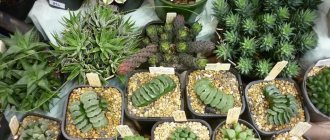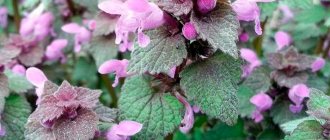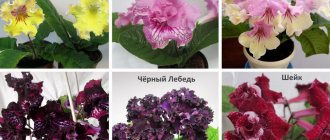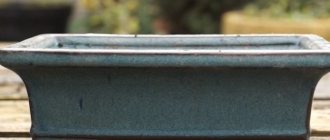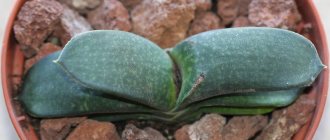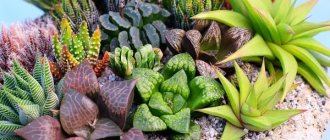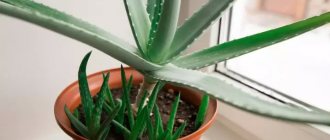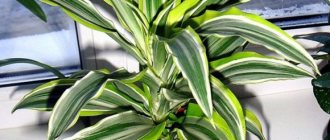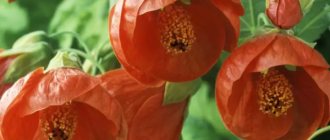Subspecies
Cooper has a fairly wide variety of subspecies:
Haworthia cooperi var. сoperi – typical species.- Haworthia cooperi var. truncata (truncata) - has truncated leaves.
- Haworthia cooperi var. pilifera is the most widespread variety and has short, low, blue-green leaves with faint bristles.
- Haworthia cooperi var. dielsiana / joeyae - common in cultivation, with blue-green, short, low leaves without fuzzy bristles, rounded tips.
- Haworthia cooperi var. davidii is a variety whose leaves are long, completely translucent, with possible red veins.
- Haworthia cooperi var. leightonii - a variety that predominates in the east, bears fruit well, the leaves are reddish in the sun.
- Haworthia cooperi var. doldii is a variety that has thin, narrow and sharp leaves.
- Haworthia cooperi var. puberula is a variety with thin, narrow and “fluffy” yellow-green leaves.
- Haworthia cooperi var. venusta is a variety whose leaves are thick, dense, small, “fluffy” and blue-green in color.
Description of the Haworthia Cooper succulent
Plant classification
Scientific name: Haworthia cooperi Synonyms: Haworthia cooperi var. cooperi, Catevala cooperi, Catevala vittata, Haworthia vittata Common name: Cooper's Haworthia Family: Asphodelaceae Subfamily: Asphodeloideae Genus: Haworthia
Haworthia Cooperi succulent is a dwarf plant that is distinguished by miniature rosettes, quite fleshy, and the color of the leaves is light green. This is a slow growing crop.
A distinctive feature of the succulent is the presence of bristles with “awns”. They are located on the edges of tiny leaves. In some varieties, the leaves can end in a thread or oblong bristles. Another feature of the flower is the presence of transparent stripes located around the tips. Some varieties are characterized by complete transparency of the tip. This skin allows the necessary amount of sunlight to penetrate into the plant tissue. Haworthia Cooper blooms in spring or summer, at which time a peduncle grows up to 30 cm in length with whitish flowers. There are many hybrid varieties, in particular variegated varieties (with multi-colored leaves).
Where and how to plant?
Succulents are unpretentious plants (this is due to the harsh conditions of the natural environment in which they grow). And Haworthia was no exception. But to obtain the best results and condition of the plant, it is necessary to care for it. There are certain recommendations for it, following which will help you grow a healthy, long-lived, original and amazingly beautiful plant at home.
Lighting and location
Since in nature the plant prefers to stay in the shade of stones or rare bushes, then at home it must be kept either in partial shade or under bright but diffused sunlight.
Coopera loves plenty of light, but does not tolerate direct sunlight. Thus, the best solution would be to place the succulent near the western, eastern or southern window of the house, and being near the northern window can negatively affect the condition of the plant.
Soil requirements
Soil with a pH < 6 (non-acidic) environment is considered acceptable for Haworthia.
It takes root well in ready-made mixtures for succulents with the addition of clay or special mixtures for Haworthia. Homemade substrates made from sand, peat, humus, turf soil and brick chips in equal parts are also perfect.
Brick chips are required to prevent rotting of the roots and stem of the plant. The organic content in the soil and its breathability are very important.
Home care for the Haworthia Cooper plant
This culture is not picky, and caring for it is quite simple. The main thing is to comply with several important conditions.
Let's look at each in more detail.
What soil is suitable for Haworthia Cooper?
For succulents, soil intended specifically for succulent plants will do. But you can try and prepare the composition yourself. For such purposes, turf-clay soil, sand and sheet soil in a ratio of 1/3 are used. All components are thoroughly mixed, and it is also advisable to add crushed brick.
Information on caring for succulents
How to prepare optimal soil for succulents: the best soil mixtures
What, how and when to fertilize succulents - expert advice
How to water succulents: what gardeners advise
Lighting
Haworthia Cooperi prefers good light, but does not tolerate direct sunlight. It is advisable to place the succulent on an eastern or western windowsill. If you place the plant on the north side, this will lead to the flower losing its color and shape.
Temperature indicators
Excessively high and too low temperatures are detrimental to crops. It is better to choose the “golden mean” when the temperature fluctuates between +23...25 degrees. In winter, the temperature drops to +12...15 degrees, giving the succulent peace.
Watering
The culture is drought-resistant. Therefore, it is recommended to water the plant no more than once every 7-10 days. For such purposes, it is best to use non-cold water. The main criterion signaling the need for watering is the complete drying of the soil. But, make sure that there is no over-watering. In winter, watering is carried out only once a month, using cool water.
Fertilizers
The culture responds well to feedings that are suitable for succulents and cacti. Avoid formulations that contain a lot of nitrogen. It is absolutely not suitable for these plants. It is recommended to apply all fertilizers in the summer.
Transplanting a plant
Such a succulent can only be replanted if it feels cramped in the pot. It is optimal to choose round containers for such purposes, shallow but wide enough.
The plant should be replanted according to the following scheme:
- We place drainage at the bottom of the container.
- We fill the soil on top of the drainage layer.
- Place the succulent in the center.
- Cover the surface of the roots with soil and compact the soil a little.
- Add a little soil if needed.
We carry out all manipulations as carefully as possible so as not to damage the culture.
How to properly care?
- Temperature.
Up to 30 0C in spring-summer, and 17-19 0C in autumn-winter. Such low temperatures in winter ensure that the plant remains dormant. This is a necessary period in the life cycle of a succulent.This variety of Haworthia is adapted to dry air. Therefore, it does not require spraying, and in the warm season you can take it outside in partial shade.
- Watering.
It is recommended to water Cooper from a tray. In summer and spring up to 2 times a week, and in winter and autumn up to 2 times a month:- Pour water into the pan.
Place the pot in the tray.
- After 10 minutes, drain the remaining water from the pan.
- Fertilizer.
Traditional succulent food is suitable for this. It can be used from March to October no more than once a month. Complementary feeding is necessary for the plant during the period of active growth. During the rest period, complementary feeding is not necessary.An excess of minerals negatively affects the condition of the plant.
- Diseases.
The most important thing in growing Haworthia Cooper is compliance with agricultural techniques. For example, when overwatered, the tips of the leaves darken and the plant dies, and when there is a lack of light, the plant loses its decorative properties and color, the leaves can lengthen and wither. Damaged leaves should be removed immediately.Haworthia can be affected by aphids or mealyworms. If the area of damage is not too large, then you can treat the plant with a soap solution, otherwise it is better to get rid of it.
Features of reproduction
Haworthia cooperi is propagated by seeds, leaves or side shoots:
- Propagation by seeds occurs in the traditional way. Seeds are bought at a flower shop and planted. The growth process is quite long and is often practiced by breeders.
- Side shoots (also called “babies”) are separated from the mother’s rosette and planted in a separate pot with substrate. But only opaque rosettes can be replanted, since transparent ones lack chlorophyll and are not ready for independent growth.
- The leaves are cut off, treated with ash or coal and “listened” for 2-3 days.
Genus Haworthia, fam. Asphodelaceae
| Haworthia flowering |
Homeland South Africa.
The genus is named after Adrian Hardy Haworth (1768–1833), an authority on succulents in the early nineteenth century. In nature there are about 150 species and many forms, including transitional ones, and a large number of hybrids have also been bred. Some of this diversity is very common in culture. There are several classifications of Haworthia: Bruce Bayer, Ingo Breuer, Masahiko Hayashi and others. The official taxonomy stands apart, the representative of which is the site Theplantlist.org. These systems are often contradictory; the official taxonomy largely does not recognize the developments of individual authors, and they do not seek consensus. Based on molecular studies of relationships within the genus Haworthia, it is divided into 3 distinct genera that roughly correspond to previously recognized subgenera. Haworthia retains those species that were previously included in this subgenus. Two other subgenera are so-called "hard" species, such as H.fasciata, now considered genera: Haworthiopsis (formerly subgenus Hexangulares) and Tulista (subgenus Robustipedunculares). The stem is usually very short. Leaves in dense basal rosettes, succulent. Based on their appearance, they can be roughly divided into three types - with hard pointed leaves, windowed and herbaceous. “Hard” leaves have triangular, opaque leaves with a hard cuticle, usually dark green, often with light specks. “Window” varieties are often distinguished by a flattened leaf tip and a translucent “window”; they have succulent leaves with the consistency of grapes and are often truncated and cylindrical in shape. Leaf color ranges from light green to brownish. Herbaceous species have succulent soft elongated triangular leaves. There are many photos of Haworthias, divided into groups according to appearance for identification: Haworthia.jp. Review article on Haworthias: PlantZAfrica. The flowers are two-lipped (with a distinct upper and lower lip), with a strongly curved tube, recurved petals, usually white or grayish-white to dull pinkish-white or greenish-white, sometimes yellowish with green in the tube, and brownish or pinkish central vein on the tepals. In most species, the floral tube gradually tapers towards the stem (pedicel), forming a short basal tube.
Culture:
Haworthias grow on drained substrates, under cover from the scorching rays of the sun by taller plants, in grass or in bushes. Most species are so-called “extra-soil plants”, i.e. preferring as a substrate not soil as such, but loose plant debris or stones.
Some species can be ordered by mail or at a meeting in Moscow. The list of plants to order is here.
Agrotechnics of cultivation
- Haworthia cooperi should be grown in round, wide, shallow pots in indirect sunlight.
- At an air temperature of 25-28 0C in spring-summer and 18 0C in autumn-winter, the plant does not need additional air humidification.
- Watering is carried out 2 times a week in the warm season and 2 times a month in the cold season.
- Fertilize no more than once a month during warm periods and periods of active growth; during the dormant period, fertilizer is not required.
- Replant no more than once a year if the succulent becomes crowded in its pot.
We invite you to learn about another very original type of haworthia - Striped. This plant somewhat resembles a small, densely growing aloe and is very popular among gardeners.
